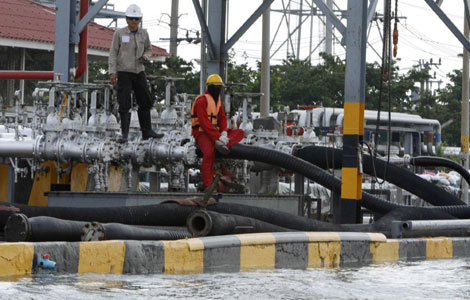Heads 'up' for Chinese approach to key space maneuver
Updated: 2011-10-31 20:37
(Xinhua)
|
|||||||||||
BEIJING - Docking may be a decades-old space technology in the eyes of veteran aerospace watchers and fans, but seeing how China is going to do it will be a new experience.
China has announced it will launch Shenzhou VIII Tuesday morning. The unmanned spacecraft is expected to practice China's first space docking with the orbiting space lab module Tiangong-1. The technology is crucial to build the nation's first space station.
Since some developed countries acquired docking technology decades ago, China plans to catch up by using more speed and cutting costs, Zhou Jianping, chief designer of China's manned space program, said in an interview with Xinhua.
Other countries' docking processes usually involve one module docking with one spacecraft. But Tiangong-1 will dock with three space vehicles, namely Shenzhou VIII, IX and X. This will cut costs significantly, Zhou said.
The world's first space docking was achieved in 1966 when the manned US spacecraft Gemini 8 rendezvoused and docked with an unmanned Agena Target Vehicle.
In one of China's most popular aerospace online forums Aerospace Port, a special thread was set up to track up-to-the-minute progress of the Shenzhou VIII mission.
"We are all keeping a close eye on the mission. I'm especially keen to know what the Chinese docking system will be like," a veteran fan nicknamed "Submarine 4809" told Xinhua.
Tim Robinson, editor of Aerospace International, said the way China is approaching space docking is very different from other countries.
"Unlike the US which started with manually flown dockings, in Gemini for example, China is attempting an automated docking first and then manned dockings," Robinson wrote in an e-mail to Xinhua.
"This probably reduces the human risk to crew, but it is also very ambitious," Robinson wrote.
The docking is one of the most risky aspects of China's manned space program. "We can never count on other countries to sell their mature technologies to us, so we have to rely on our own," chief designer Zhou said.
"Since we have never conducted a similar test before and the system is so complicated, we have many unknowns," he said. "It is highly risky."
"It is fairly difficult and risky to link up two vehicles travelling at high speeds in orbit, with a margin of error of no more than 20 centimeters," Wu Ping, spokeswoman for China's manned space program, told a press conference Monday.
A late-comer to space docking, however, China has the advantage of being able to learn from the experience of other countries, a long-time space expert Phillip Clark said.
"China has the advantage of being able to look back to see how the United States and the Soviet Union/Russia have solved problems in spaceflight and then apply those solutions to the Chinese requirements," Clark, who has been following the Chinese space adventure since the launch of Dongfanghong-1 in 1970, told Xinhua.
If Shenzhou VIII is successful in docking with Tiangong-1, Clark said, China will have a technology previously possessed by only Russia and the European Space Agency. The United States has never developed the ability to automatically complete rendezvous and docking in orbit -- it has always done the operations under manual control.
"The US and Russia have had long experience in space -- but sometimes it may be that a fresh approach finds a solution that nobody else had thought of," Robinson said.
After two docking tryouts with Tiangong-1 in the same mission, Shenzhou VIII will return to the Earth and Tiangong-1 will wait for the next docking tests.
The space docking tests and experiments conducted with the Tiangong-1 module will provide experience for China's possible construction of a permanent manned space station around 2020.
Related Stories
China to launch Shenzhou VIII early Tuesday 2011-10-31 19:28
China, Germany to operate experiments on Shenzhou-8 2011-10-31 11:25
China may send female astronauts into space in 2012 2011-10-31 18:58
China's 1st manual space docking hopefully 2012 2011-10-31 16:13
Hot Topics
Libya conflict, Gaddafi, Oil spill, Palace Museum scandal, Inflation, Japan's new PM, Trapped miners, Mooncake tax, Weekly photos, Hurricane Irene
Editor's Picks

|

|

|

|

|

|







